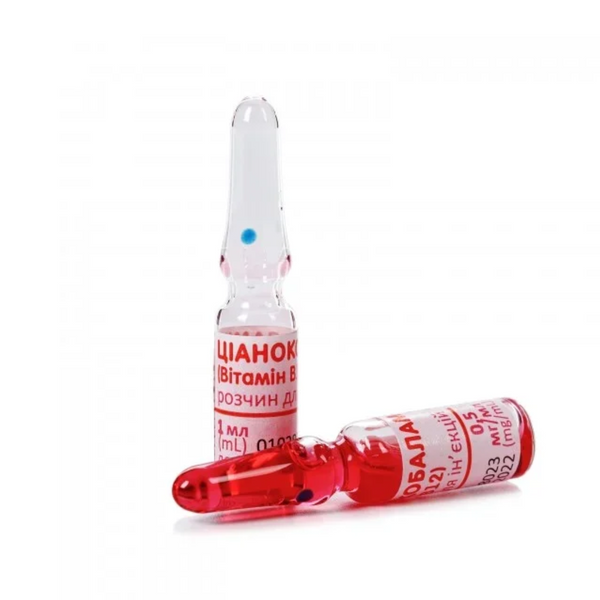|
Quantity
|
Out of stock
|
||
|
|
|||
Composition
active ingredient: cyanocobalamin;
1 ml of solution contains 0.5 mg of cyanocobalamin;
excipients: sodium chloride, water for injection.
Dosage form
Solution for injection.
Main physicochemical properties: transparent, bright red liquid.
Pharmacological group
Vitamin B12 (cyanocobalamin and its analogues).
ATC code B03B A01.
Pharmacological properties
Pharmacodynamics.
Vitamin B12 (cyanocobalamin) has a metabolic, hematopoietic effect. In the body (mainly in the liver) it is converted into a coenzyme form - adenosylcobalamin, or cobamamide, which is the active form of vitamin B12. Cobamamide is part of numerous enzymes, in particular, reductase, which restores folic acid to tetrahydrofolic acid. Has high biological activity. Cobamamide is involved in the transfer of methyl and other single-carbon fragments, therefore it is necessary for the formation of deoxyribose and DNA, creatine, methionine - a donor of methyl groups, in the synthesis of the lipotropic factor - choline, for the conversion of methylmalonic acid into succinic acid, which is part of myelin, for the utilization of propionic acid. Cobamamide is necessary for normal hematopoiesis, since it promotes the maturation of red blood cells. Participation in the synthesis and accumulation of compounds containing sulfhydryl groups in red blood cells, which increases their tolerance to hemolysis. Activates blood clotting, in high doses increases thromboplastic activity and prothrombin activity. Reduces blood cholesterol levels. Positive effect on liver and nervous system function. Increases the ability of tissues to regenerate.
Pharmacokinetics.
When administered parenterally, vitamin B12 quickly enters the systemic bloodstream. In the blood, it binds to transcobalamins I and II, which transport it to tissues. It is deposited mainly in the liver. Plasma protein binding is 90%. The time to reach maximum concentration (TCmax) after subcutaneous or intramuscular administration is about 1 hour. It is excreted from the liver with bile into the intestine and reabsorbed into the blood. The half-life (T1/2) from the liver is 500 days. With normal renal function, 7-10% is excreted by the kidneys, about 50% with feces; with reduced renal function, 0-7% by the kidneys, 70-100% with feces. It penetrates the placental barrier.
Indications
Treatment of malignant, posthemorrhagic and iron deficiency anemia, aplastic anemia in children, anemia of alimentary origin caused by toxic substances and drugs associated with vitamin B12 deficiency, regardless of the causes of deficiency (gastric resection, helminthic processes, pregnancy). Polyneuritis, trigeminal neuralgia, radiculitis, causalgia, migraine, diabetic neuritis, amyotrophic lateral sclerosis, cerebral palsy, Down's syndrome, alcoholic delirium. It is used for dystrophy in children, after infectious diseases, cruciate erythematosus (together with folic acid), liver diseases (hepatitis, cirrhosis, Botkin's disease), radiation sickness, psoriasis, herpetiform dermatitis, neurodermatitis, photodermatoses.
Contraindications
Hypersensitivity to the components of the drug. Erythremia, erythrocytosis. Neoplasm, except for cases accompanied by megaloblastic anemia and vitamin B12 deficiency. Acute thromboembolic diseases. Angina pectoris, high functional class stress.
Interaction with other drugs and other types of interaction
Aminoglycosides, salicylates, antiepileptic drugs, colchicine, potassium preparations reduce the absorption of the drug, affect its kinetics. When used simultaneously with kanamycin, neomycin, polymyxins, tetracyclines, the absorption of cyanocobalamin decreases. Pharmaceutically incompatible with ascorbic acid, salts of heavy metals (inactivation of cyanocobalamin), thiamine bromide, pyridoxine, riboflavin (the cobalt ion contained in the cyanocobalamin molecule destroys other vitamins).
When used simultaneously with thiamine, the risk of allergic reactions caused by thiamine increases.
Chloramphenicol reduces the hematopoietic response to the drug.
When used simultaneously with cytamen, the effect of cytamen decreases.
Oral contraceptives reduce the concentration of cyanocobalamin in the blood.
Special instructions for use
Cyanocobalamin should not be used with drugs that increase blood clotting. During treatment with cyanocobalamin, it is necessary to monitor peripheral blood parameters: on the 5th-8th day of treatment, the content of reticulocytes and iron concentration are determined. The number of erythrocytes, hemoglobin and color index should be monitored for 1 month 1-2 times a week, and then 2-4 times a month. Remission is achieved when the number of erythrocytes increases to 4.0-4.5* 1012 /l, when normal erythrocyte sizes are achieved, aniso- and poikilocytosis disappears, and the reticulocyte content normalizes after the reticulocyte crisis. After reaching g
hematological remission, peripheral blood monitoring is performed at least once every 4-6 months.
With regard to patients with a tendency to thrombosis and patients with angina pectoris, caution should be exercised during treatment and blood clotting should be monitored.
If there is a tendency to develop leukocytosis and erythrocytosis, the dose should be reduced or treatment should be temporarily suspended.
Use during pregnancy or breastfeeding.
Use during pregnancy is possible only under the supervision of a physician with caution, taking into account the risk/benefit ratio (there is some data on the teratogenic effect of vitamin B12 in high doses). Use during breastfeeding is possible only after assessing the risk/benefit ratio.
Ability to influence the reaction rate when driving a vehicle or other mechanisms.
During treatment, it is necessary to refrain from driving vehicles and potentially dangerous activities that require increased attention and speed of psychomotor reactions.
Method of administration and dosage
Cyanocobalamin is administered intramuscularly, subcutaneously or intravenously, and in case of lateral funicular myelosis and amyotrophic lateral sclerosis also intralumbarly.
Adults.
In case of B12-deficiency anemia, the drug is used in doses of 100-200 mcg (0.1-0.2 mg) every other day until remission is achieved.
When symptoms of funicular myelosis and macrocytic anemia with damage to the nervous system appear, cyanocobalamin is used in a single dose of 400-500 mcg (0.4-0.5 mg) or more. During the first week, it is administered daily, and then at intervals of 5-7 days (folic acid is prescribed at the same time). In severe cases, it is administered into the spinal canal starting with a single dose of 15-30 mcg, and with each subsequent injection the dose is increased (50, 100, 150, 200 mcg). Intralumbar injections are given every 3 days, a total of 8-10 injections are required per course. During the period of remission, in the absence of funicular myelosis, 100 mcg are prescribed for maintenance therapy twice a month, in the presence of neurological symptoms - 200-400 mcg 2-4 times during the month.
In case of amyotrophic lateral sclerosis, encephalomyelitis, neurological diseases with pain syndrome, it is administered in increasing doses from 200 to 500 mcg per injection (with improvement - 100 mcg per day). The course of treatment is 14 days. For peripheral nerve injuries, 200-400 mcg is prescribed once every 2 days for 40-45 days.
For hepatitis and liver cirrhosis, adults are prescribed 15-30 mcg per day or 100 mcg every other day for 25-40 days.
For diabetic neuropathy, sprue, radiation sickness, 60-100 mcg is administered daily for 20-30 days.
For vitamin B12 deficiency, for treatment - intramuscularly and intravenously 1 mg every day for 1-2 weeks, maintenance dose - 1-2 mg intramuscularly or intravenously from 1 time per week to 1 time per month. The duration of treatment with cyanocobalamin and repeated courses depend on the course of the disease and the effectiveness of treatment.
Children.
Administered only subcutaneously.
For posthemorrhagic and iron deficiency anemia, 30-100 mcg is prescribed 2-3 times a week. For aplastic anemia in children, 100 mcg is administered until clinical and hematological improvement occurs. For alimentary anemia in childhood, 30 mcg is prescribed for 15 days.
For dystrophies in young children, Down's syndrome and cerebral palsy, 15-30 mcg is prescribed every other day.
For hepatitis and liver cirrhosis, children are prescribed 15-30 mcg per day or 100 mcg every other day for 25-40 days.
Children
In this dosage form and in this dosage, the drug is not used for children under 3 years of age. It is administered subcutaneously only.
Overdose
Overdose may cause pulmonary edema, congestive heart failure, peripheral vascular thrombosis. Symptomatic therapy.
Side effects
Blood: hypercoagulation.
Cardiovascular: tachycardia, heart pain.
Nervous: headaches, dizziness, nervous excitement.
Immune: allergic reactions, including skin manifestations (hyperemia, urticaria, rash, itching, dermatitis), edema, including Quincke's edema; respiratory failure, including asthma, anaphylactic shock, anaphylactoid reactions.
Metabolism: acne, bullous rash, nausea, sweating, purine metabolism disorder.
Gastrointestinal: loose stool.
General disorders: malaise, fever.
Local reactions: hyperemia, itching, pain, swelling, compaction and necrosis at the injection site.
Incompatibility
When used in one solution of cyanocobalamin with ascorbic acid, pyridoxine, mutual destruction of vitamins occurs, with nicotinic acid - destruction of cyanocobalamin, with riboflavin - accumulation of cobalt ions.
Shelf life
2 years.
Storage conditions
Store in the original packaging at a temperature not exceeding 25 ° C.
Keep out of reach of children.
































